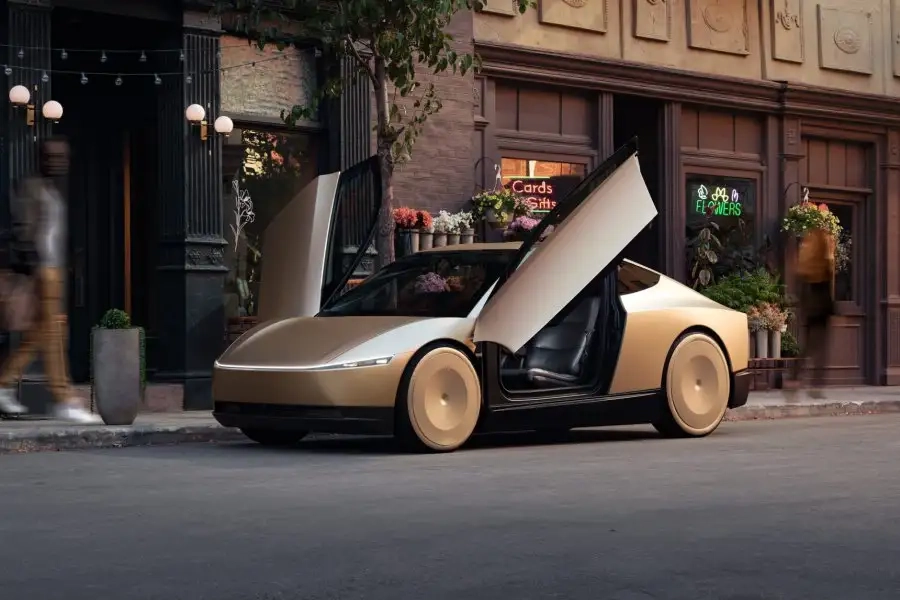
The Tesla Cybercab is an upcoming robotaxi designed to function autonomously, forming a key part of Tesla’s push toward fully self-driving vehicles. This vehicle is expected to debut with no steering wheel or pedals, relying entirely on Tesla’s Full Self-Driving (FSD) technology. Tesla teased the Cybercab in a promotional video earlier this year, showing a minimalist, two-passenger interior with an infotainment system between the front seats, but no manual controls for driving.
Scheduled to launch at Tesla’s “We, Robot” event in October 2024, the Cybercab resembles the Cybertruck in its exterior design and will play a central role in Tesla’s broader autonomous vehicle plans. It highlights Elon Musk’s vision for a fleet of robotaxis that could reshape the ride-hailing industry by providing driverless services. The project has been in development for several years, and Musk has emphasized it as a strategic priority over other Tesla models.
Despite excitement surrounding the Cybercab, there are concerns about the readiness of Tesla’s autonomous driving software. While Tesla’s FSD technology has shown potential, it has faced criticism and scrutiny from U.S. regulators following several accidents involving Tesla vehicles operating in FSD mode. Additionally, some analysts remain skeptical about whether Tesla will meet its ambitious goals in terms of safety and functionality.
Overall, the Cybercab represents Tesla’s continued drive toward revolutionizing transportation with autonomous technology, although it still faces significant technical and regulatory hurdles before reaching widespread adoption
The Tesla Cybercab is a key project in Tesla’s ongoing push to revolutionize transportation with autonomous vehicles. Here’s more detailed information about this robotaxi:
- Design and Features: The Cybercab’s design is inspired by the rugged, angular aesthetic of Tesla’s Cybertruck. It is a fully autonomous vehicle, meaning it lacks traditional driving components such as a steering wheel or pedals. The interior, as teased by Tesla in a promotional video, features two passenger seats and an infotainment system positioned between the seats, catering to passengers rather than a driver
- Autonomous Technology: Tesla is banking on its Full Self-Driving (FSD) software to power the Cybercab, but this technology has been controversial. While Tesla has made strides in developing autonomous driving features, the system has yet to deliver complete self-driving capabilities without human oversight. Multiple incidents, including fatal crashes involving Tesla’s FSD software, have prompted investigations by U.S. regulators
- Strategic Importance: The Cybercab marks Tesla’s attempt to dominate the ride-hailing and robotaxi markets, challenging traditional companies like Uber and Lyft. Elon Musk has stated that the Cybercab represents the future of transportation, focusing on reducing the need for human drivers. Tesla sees this as a significant growth opportunity, projecting it as a critical element in the company’s long-term vision
- Challenges and Skepticism: Despite the hype, there are skeptics. Some analysts doubt whether Tesla can deliver a truly autonomous vehicle that is safe enough for widespread public use. Concerns about the readiness and safety of Tesla’s FSD software persist, especially as it has faced multiple investigations for accidents involving cars operating in autonomous modes. The Cybercab launch is therefore seen as a high-stakes moment for Tesla’s broader strategy
- Market Impact: The Cybercab could significantly impact the ride-hailing industry by reducing operating costs associated with human drivers. Tesla also aims to develop its own ride-sharing app, which would be a major step toward creating a fully integrated autonomous transport ecosystem
- Launch and Future Plans: The Cybercab was officially unveiled at the “We, Robot” event in October 2024, a highly anticipated showcase of Tesla’s advancements in robotics and AI. Production is expected to begin in late 2024 or early 2025. This launch is seen as the beginning of a new phase for Tesla, which also includes future plans to release an Optimus humanoid robot by 2026
Overall, the Cybercab embodies Tesla’s vision of an autonomous future but faces challenges in proving that it can deliver safe, reliable self-driving vehicles at scale.
Tesla Cybercab, Autonomous vehicles, Driverless taxi, Tesla robotaxi, Self-driving cars, Electric ride-hailing, Futuristic transportation, Tesla autonomous technology, Cybercab features, Urban mobility, Full Self-Driving (FSD), Tesla Cybertruck design, Autonomous ride-sharing, Future of transportation, Robotaxi service

0 Comments